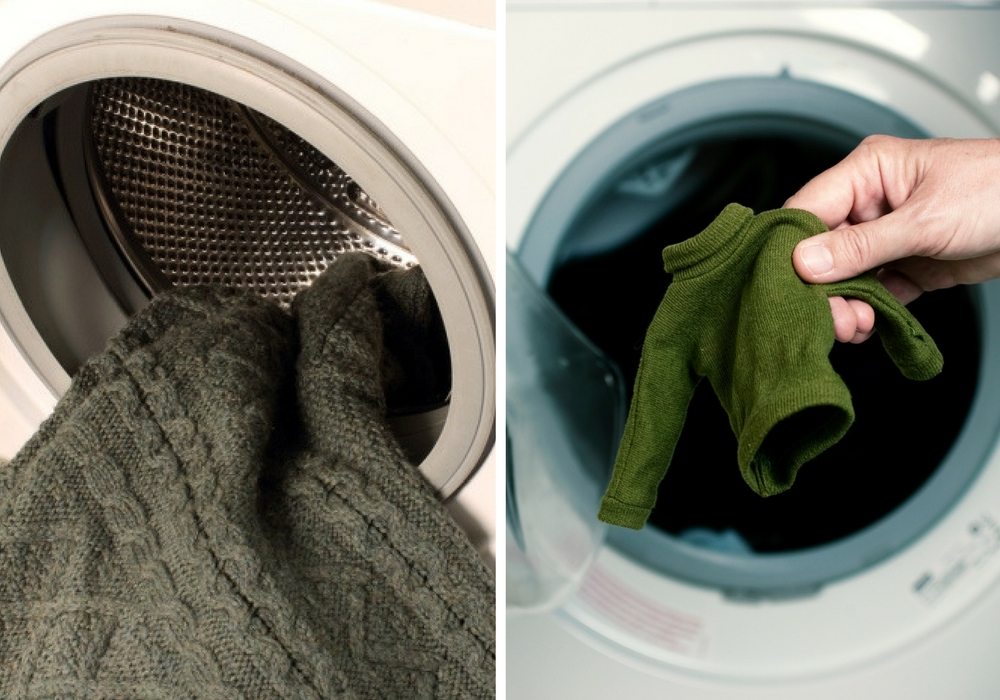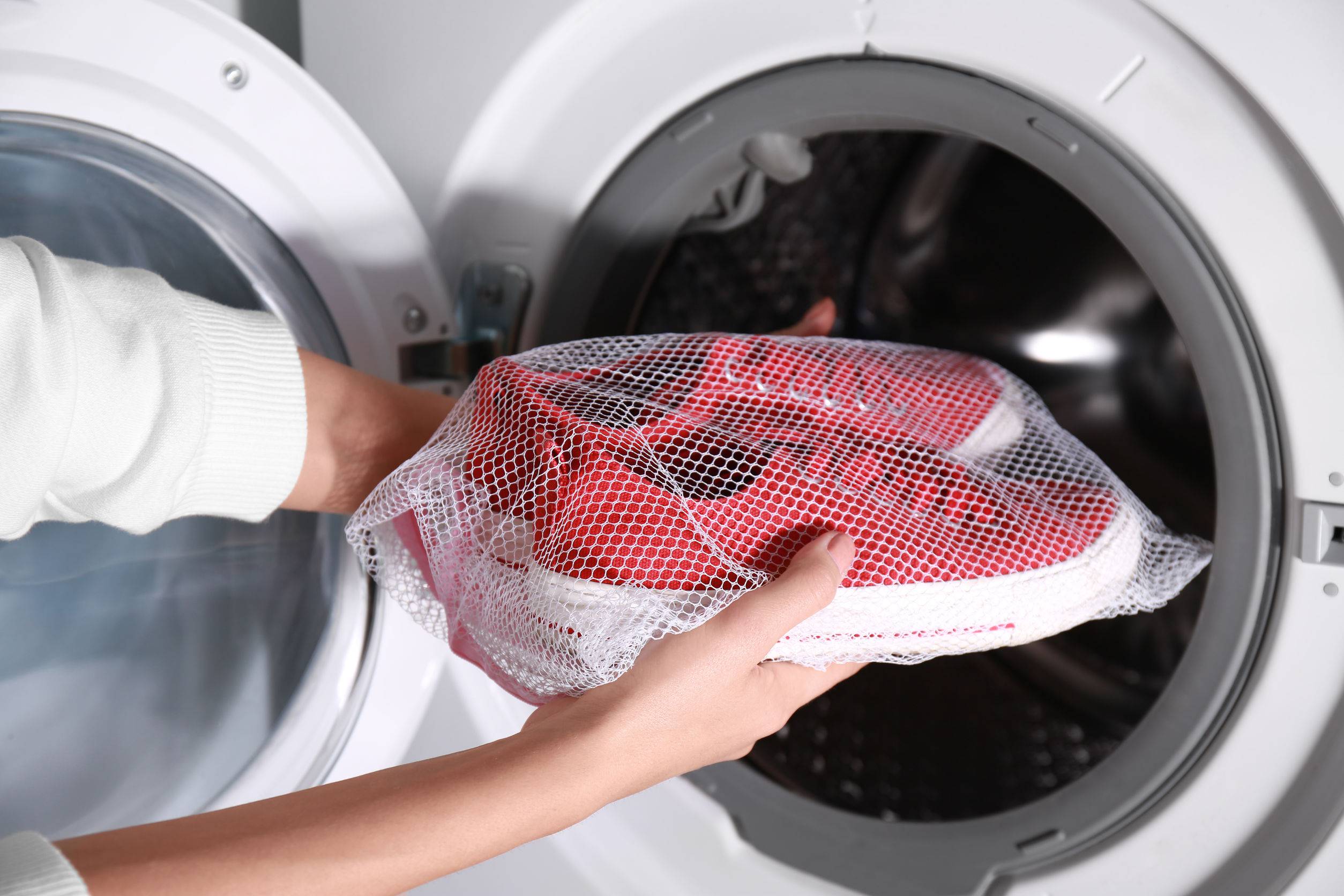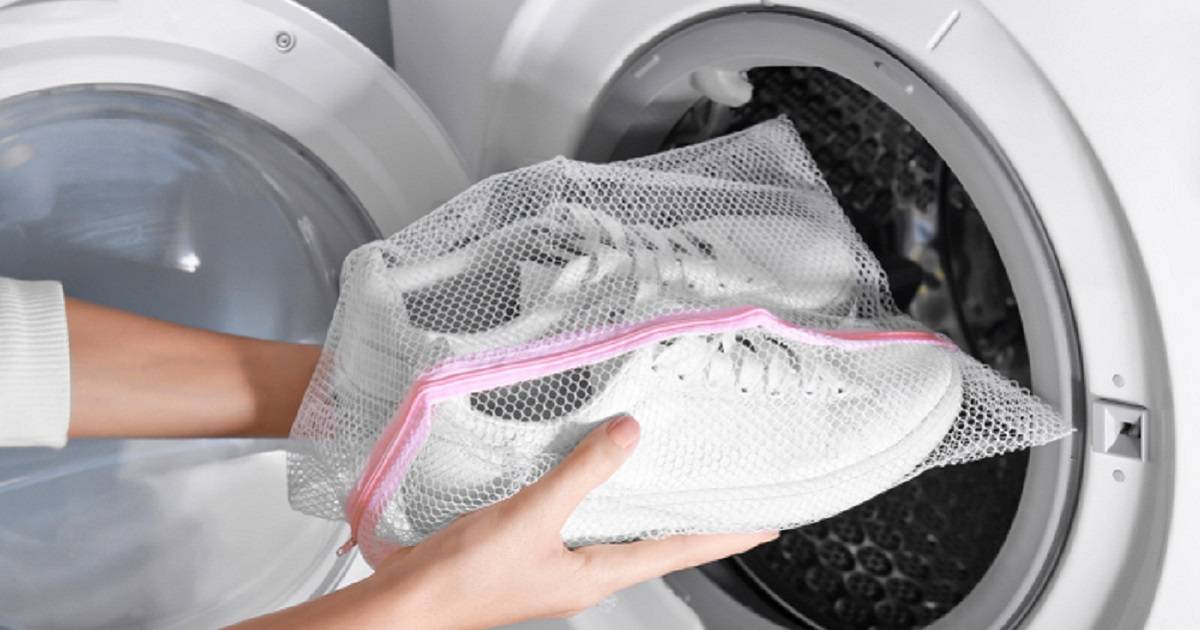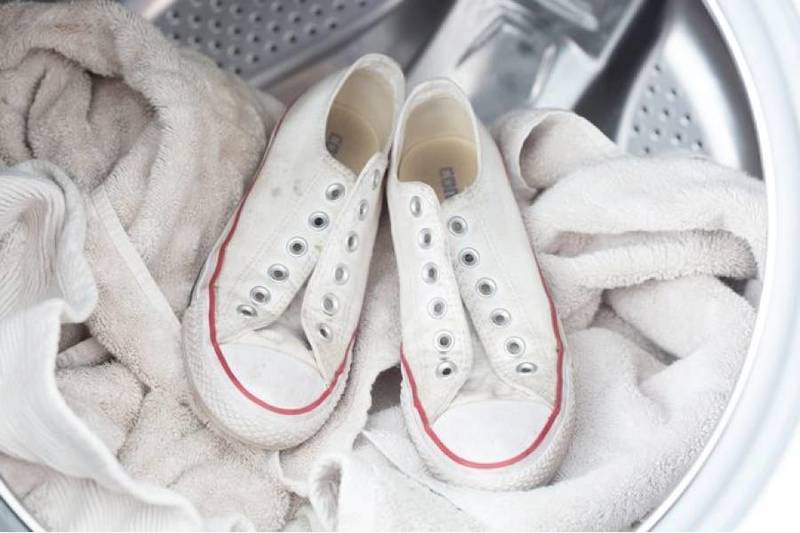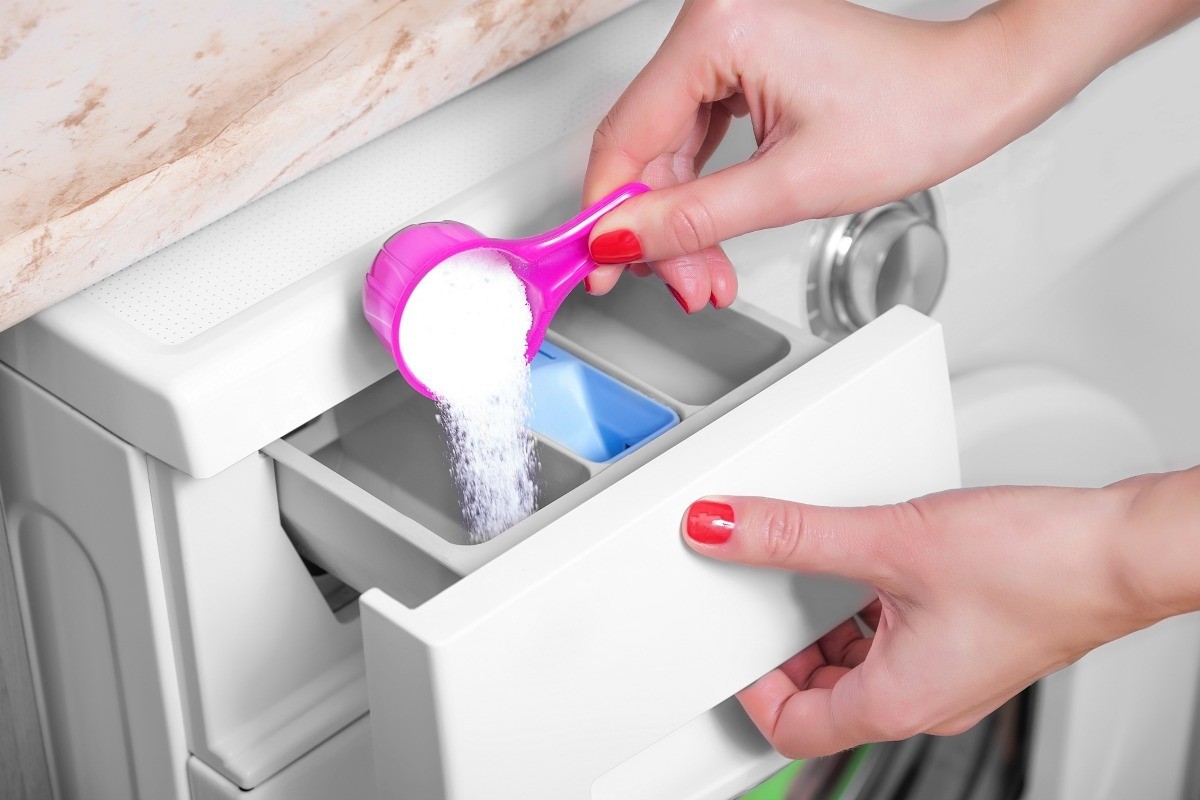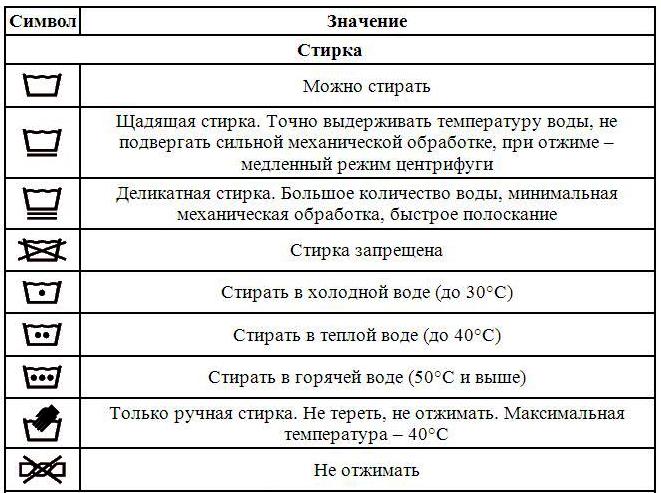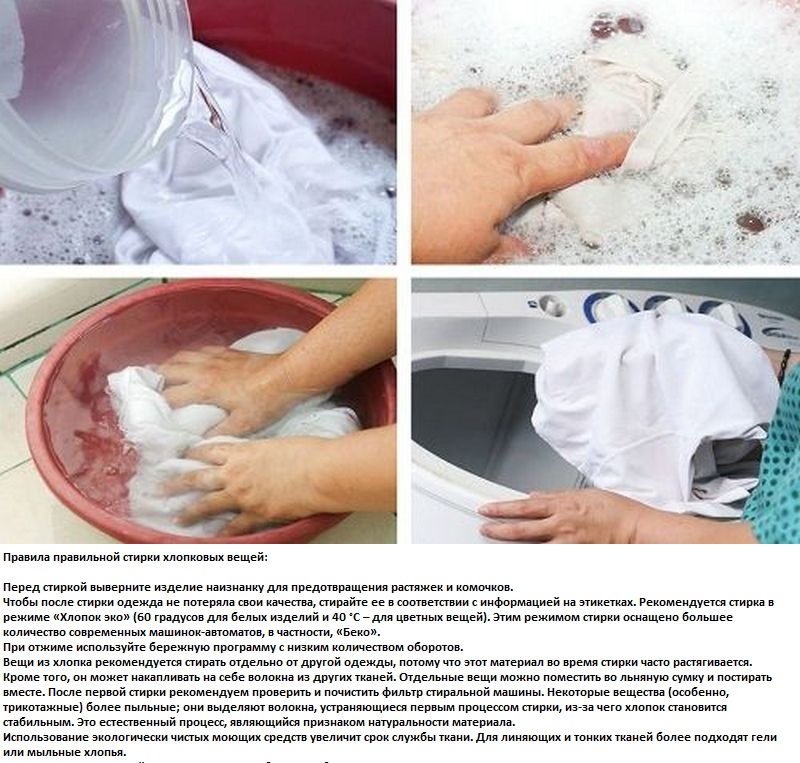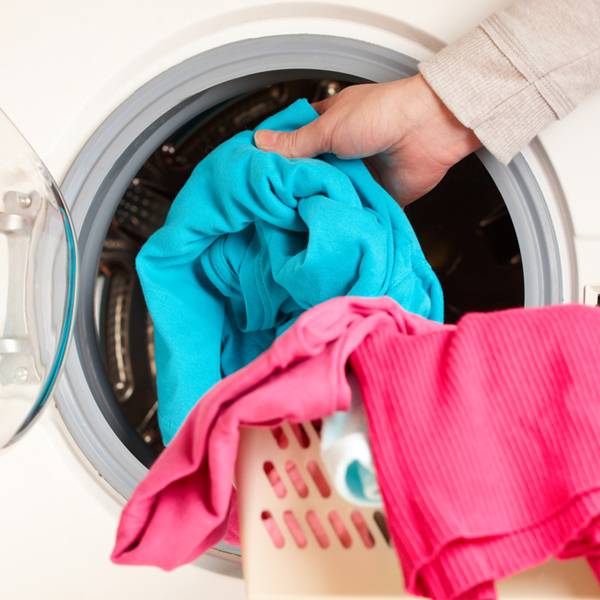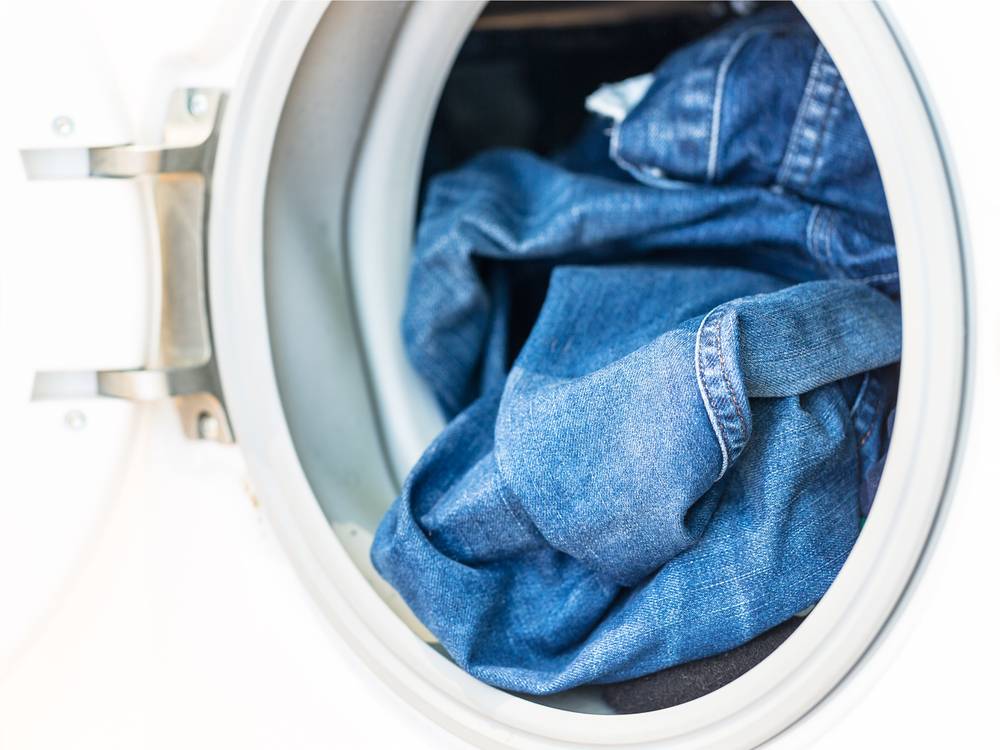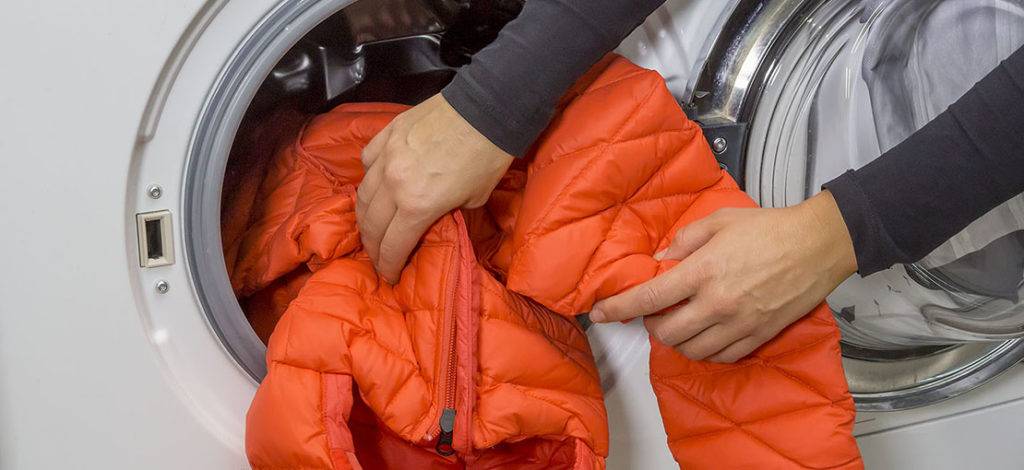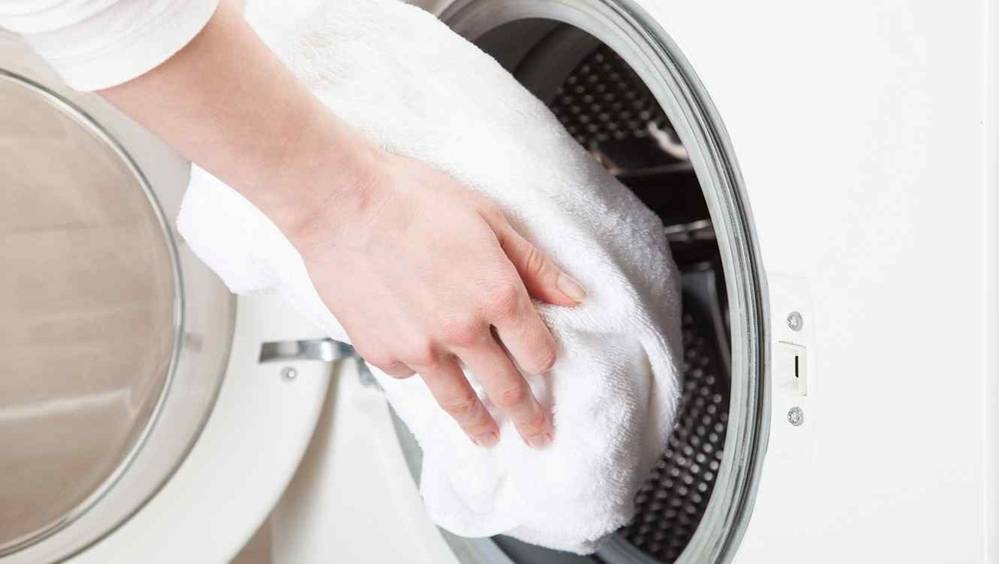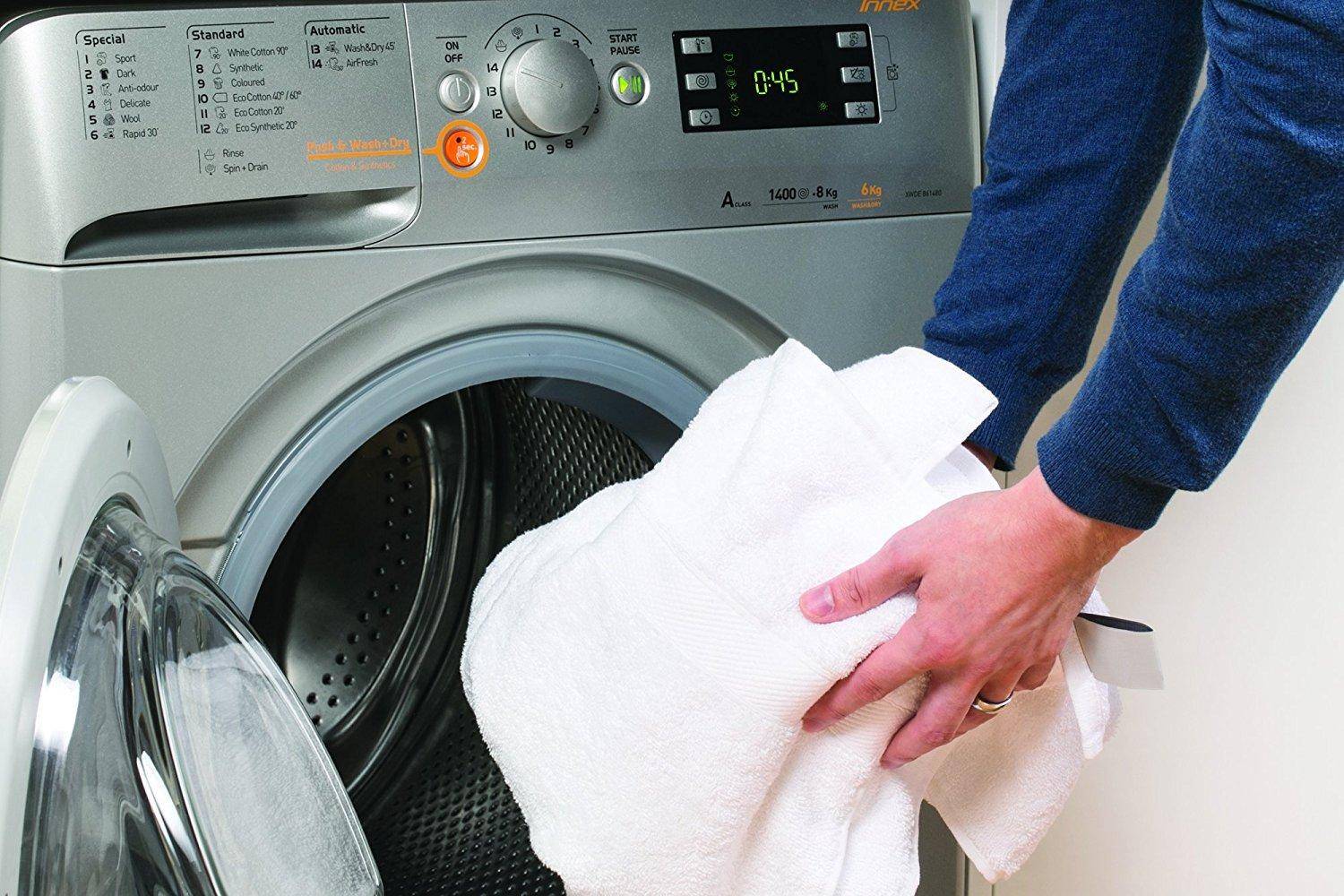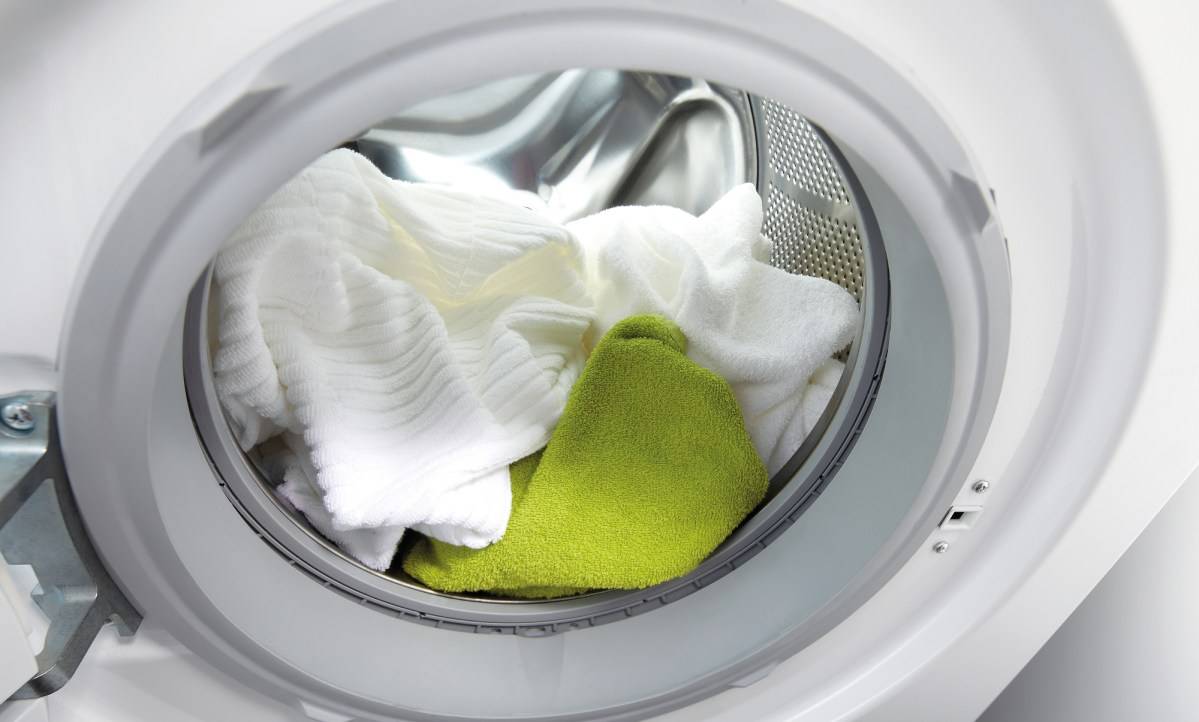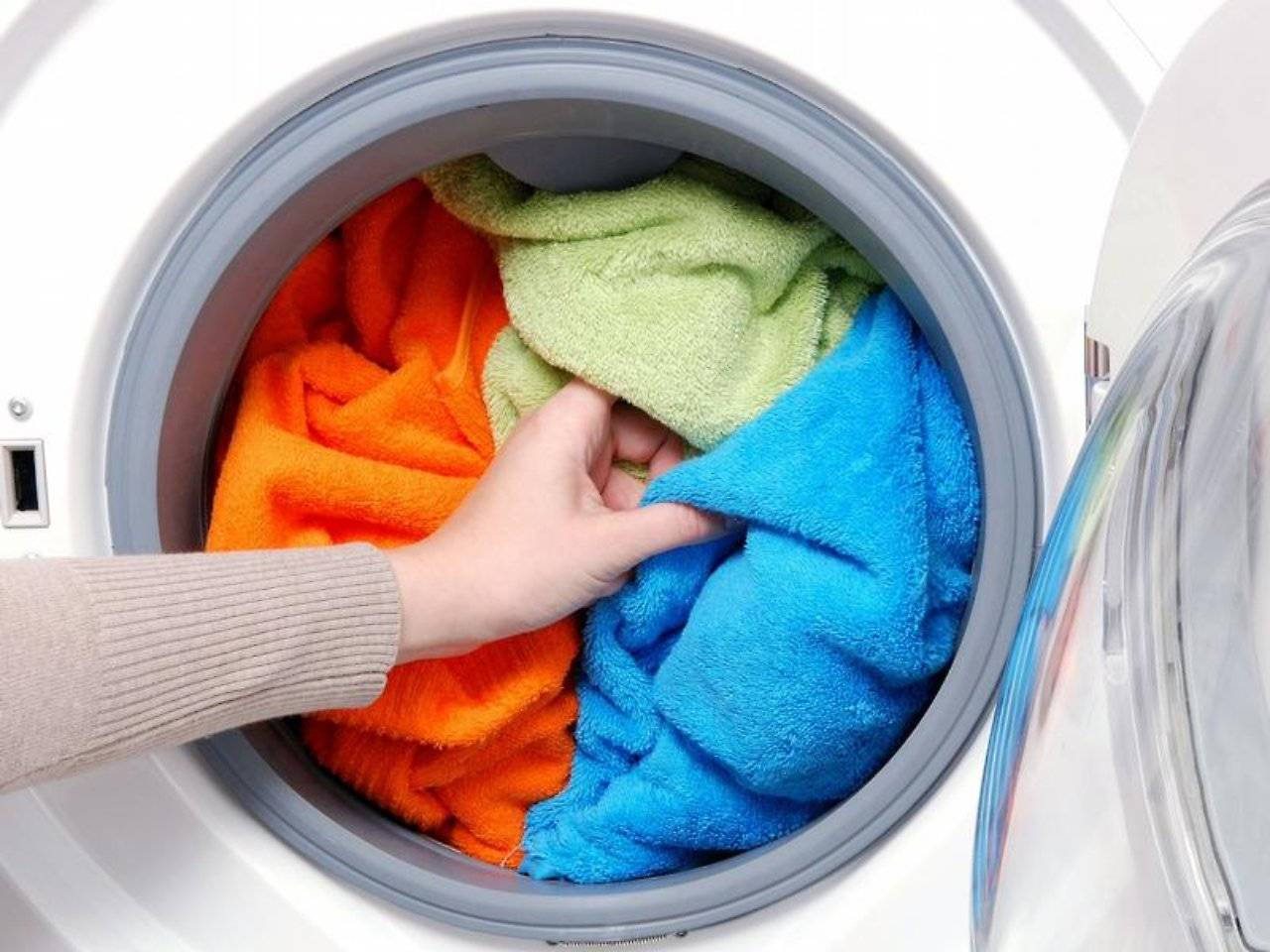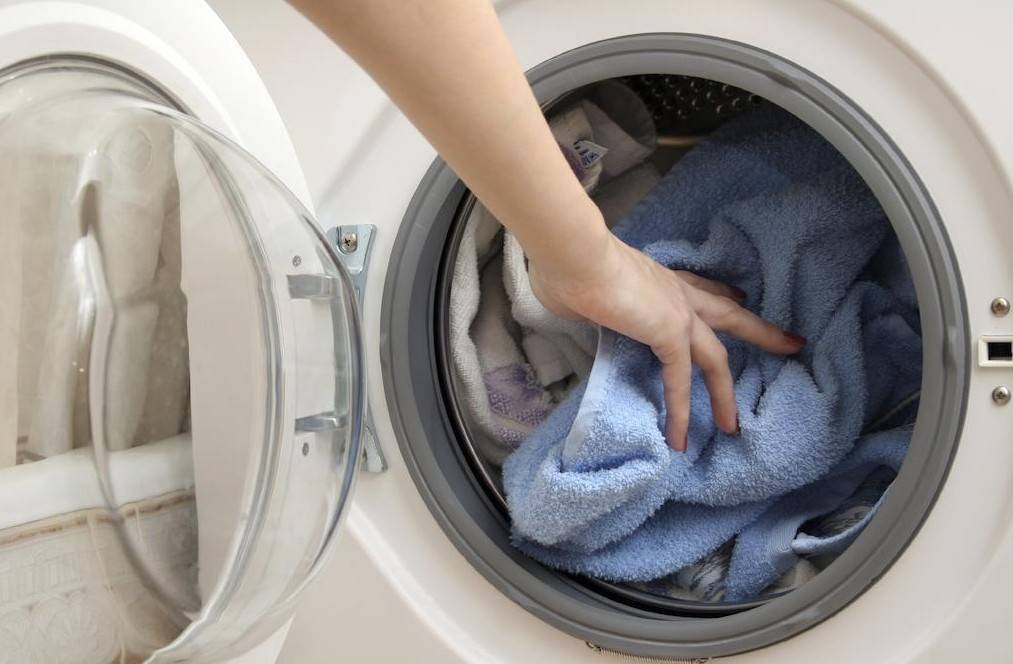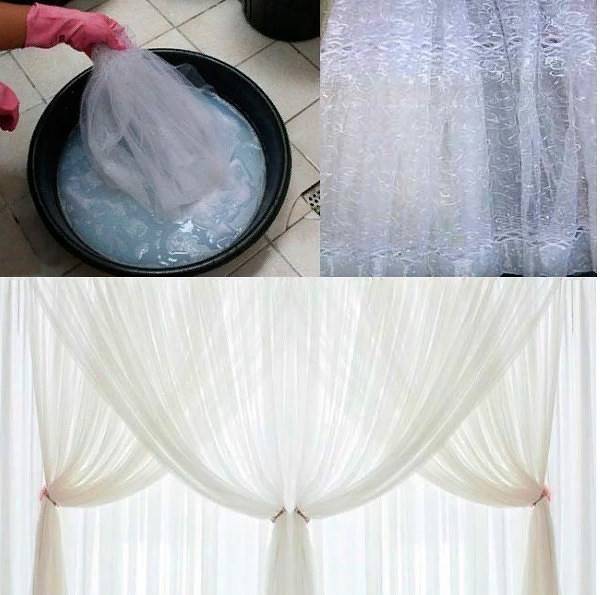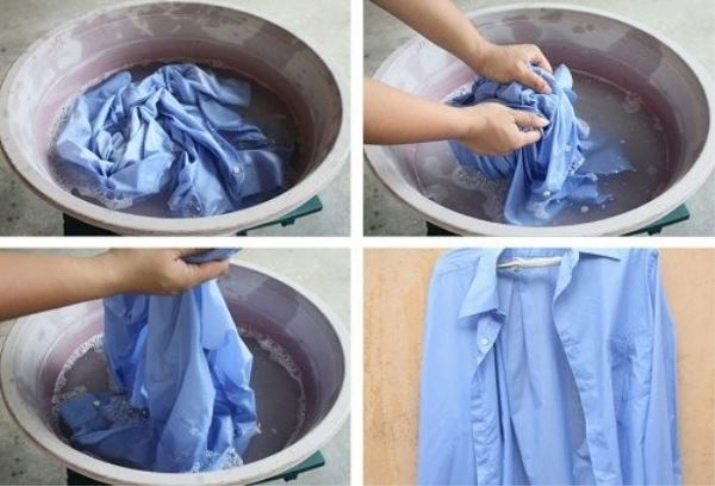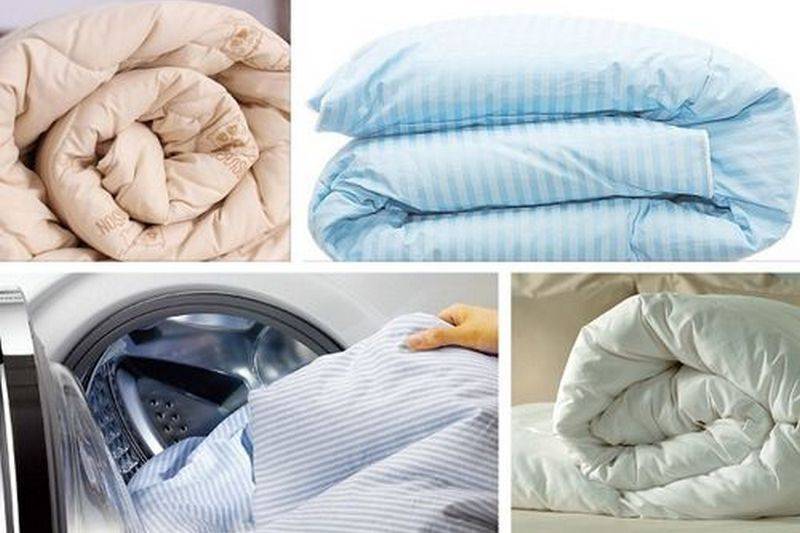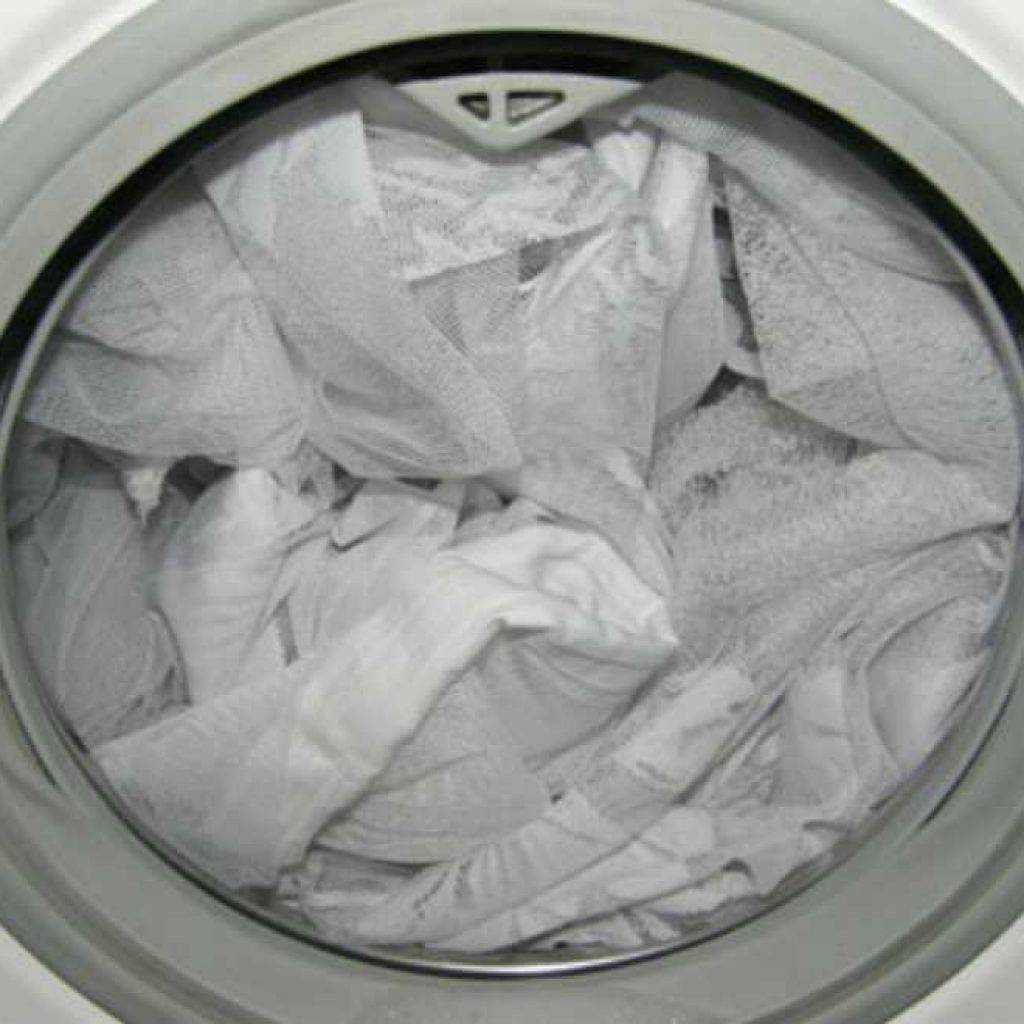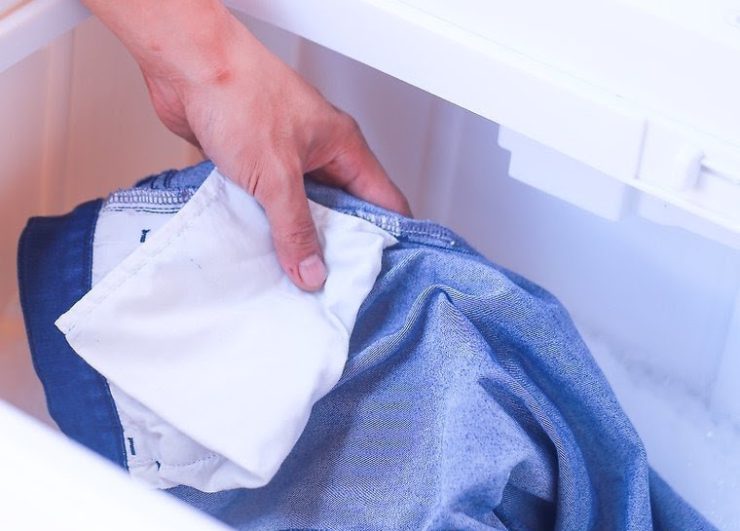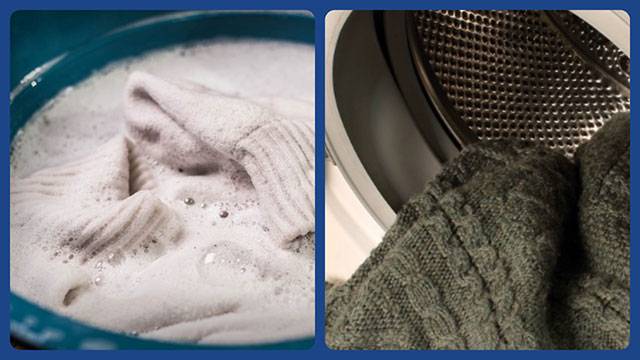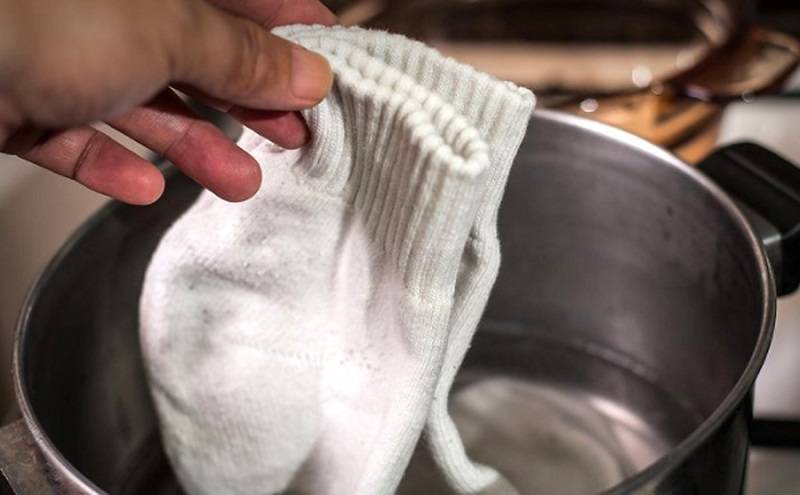Choice of detergents
When choosing a suitable program and temperature regime for washing and spinning, you can be guided by the signs that are given on the labels sewn on the clothes.
But if such labels have not been preserved, you can follow the general recommendations:
- Sturdy light cotton and linen fabrics can be washed at 95 degrees and spinned at maximum speed.
- Colored cotton linen can be washed in hot water up to 60 degrees, and they are not afraid of spinning at the highest speeds.
- It is recommended to wash things made of synthetic fabrics at a temperature not exceeding 50 degrees and to wring out at a speed of 800-900 rpm.
- For washing delicate fabrics (for example, wool or silk), it is permissible to heat the water to no more than 40 degrees, and to wring it out at low speeds - no more than 600 per minute.
- It is better to wash things that can shed in cool water not higher than 30 degrees.
The choice of powder should be in accordance with the type of fabric and type of contamination, guided by the information on the package. Its amount must also be determined in accordance with the instructions.
The two main types of contaminants are water-soluble (sweat, salt, readily soluble oils) and water-insoluble (dust, sand, grease, pigments). The former are easily washed off with a solution from water and washing powder, to eliminate the latter, one often has to resort to dry cleaning.
Preparing to wash: what does the label tell you about?
Immediately before loading the machine, all items must be prepared for washing. The first step is to check your pockets - it will be very annoying to wash money, travel tickets, flash drives, business cards or other necessary items.
It is recommended to turn the pillowcases and duvet covers inside out and shake the feathers out of their corners. You should also turn out stockings, socks, and knitwear or terry cloth. Small items and underwear are best placed in a special washing bag.
Of course, it is better not to leave stains on clothes for a long time, but if they "survived" before washing, treat them with special means.
Washing clothes of any color, and even more so white, should begin with studying the label for the product.
The manufacturer indicates on it all the nuances of processing:
- possible type of washing;
- permission or prohibition to conduct dry cleaning;
- the possibility of ironing and in what mode, at how many degrees to carry it out, as well as other useful information.
- you can irrevocably spoil the thing. In addition to studying information from the manufacturer, before washing it is necessary to inspect the thing for defects:
- a line torn along the seam;
- poorly fastened buttons;
- stains, etc.
It is necessary to eliminate them before the main wash, regardless of whether it will be carried out by hand or in the washing machine. Next, things should be sorted by color and washing criteria.
It is advisable to wash white clothes separately not only from colored ones, but also from those having even a light, barely noticeable shade.
You can find out if you can wash white and color here. Is it possible to wash white and gray together, read here.
Is it possible to wash black with a different color
White
If white products were accidentally damaged by washing with dark ones, peroxide can save them. It is necessary to process the painted areas with it, then after 30 minutes wash things in the machine. Using oxygenated bleach in this situation will increase the chances of the garment returning to its original color.
Red
You can save red things from black dye by washing them with laundry soap. Next, it is worth soaking the clothes for half an hour in warm soapy water. The following solution will help to return the red pigment: 20 g of vinegar (9%) and a little baking soda per 1 liter of water.
Green
To restore the green color, you should put the product in cold water for a while, in which alum or ordinary greenery was previously dissolved. The choice of product depends on the intensity of the original shade.
Blue
Antilin is a salvation for blue and blue things. In this case, the usual bluing will help to return the color. By the scale of the trouble and the saturation of the shade of blue, the required amount of soaking agent is determined.
Gray
Gray items can safely tolerate washing with black items. In this case, it is advisable to use a gentle mode of operation of the machine at a low temperature.
Washing machine reliability rating
Take your pick! You have 2 votes.
Lg
Overall score
171
32
–
+
203
Bosch
Overall score
111
14
–
+
125
Samsung
Overall score
94
11
–
+
105
"Ariston"
Overall score
75
7
–
+
82
"Mile"
Overall score
62
6
–
+
68
"Electrolux"
Overall score
50
3
–
+
53
"Zanussi"
Overall score
49
7
–
+
56
"Indesite"
Overall score
39
11
–
+
50
Atlant
Overall score
37
13
–
+
50
"Siemens"
Overall score
18
10
–
+
28
Removing stains
It is better to start washing any clothes with a preliminary examination for stains. You can remove food and other contaminants from black clothes using certain proven means:
- Vodka will remove any stains, even old ones, left by the deodorant.
- Dishwashing detergent removes greasy food stains well. The addition of baking soda will enhance the cleansing effect.
- Glycerin, mixed in a 1: 1 ratio, works great on a variety of stains.
- Table salt, dissolved in cool water, perfectly removes blood stains.
These products and solutions must be used to treat problem areas before washing.
Turning off the water tap after washing?
Oh yes, no.
Video tips to keep items from losing their black color
The following methods can be used to preserve the saturation of the shade of a black product:
After such manipulations, it is worth adding conditioner when rinsing. It will get rid of unnecessary odors.
If black clothes have already lost their original appearance, folk tricks can help:
- A new fading item will "share" its dye with faded clothing and renew it.
- Adding the infusion of black tea before rinsing will freshen the color of the product.
- Natural ground coffee dissolved in hot water will add color saturation in 20-30 minutes.
- The cooled infusion of tobacco (15-20 g per liter of boiling water) improves the color of black things.
And if folk methods are not suitable, you can buy an industrial dye in the store.
So, it is better to wash black things separately from the rest, following the instructions on the tag. It is also worth remembering to properly dry dark clothes. It is better to hang them in the shade in the wind or draft in order to avoid the harmful effects of sunlight and heating devices on color saturation.
Installing the washing machine
Before you start washing, it is better to make sure that the machine is installed correctly, will not vibrate and move during operation. The unit must only be placed on a hard floor, leveling it and securing the legs firmly with locknuts. If you are placing the unit on smooth tiles, place a thick rubber mat underneath to prevent slipping.
It is logical to store dirty laundry in the bathroom in a wicker basket or drawer with small holes.
Do not wash items that are too large or too small together (for example, a sheet with socks) to avoid unbalancing the machine.
It is not necessary to weigh the laundry before each wash - it is enough to remember that a full load for cotton linen is a completely filled, not tamped drum, for synthetics - a drum half full, and for wool, a drum that is a third full.
Removing various types of stains
On shirts and T-shirts, yellow spots appear most often in the armpit area. Also, traces of drinks often remain on things. Often there is a need to wash things from rust and grease stains. Pen and felt-tip contamination is especially corrosive.
Yellow under the arms
It is recommended to use alcohol to remove traces of sweat from clothes. This requires:
- take 96% alcohol and dilute it in water - it is enough to dilute 120 g of alcohol in 220 g of water;
- moisten a cotton pad in the solution;
- treat it with a yellow spot around the entire perimeter;
- wait a couple of hours;
- wash the product.
It is allowed to add a small spoonful of salt to the alcohol solution.
From drinks
- Take a large spoonful of vinegar and mix with 1/2 small spoonful of dish soap.
- Stir the mixture.
- Treat the stain with it.
- Wait 15 minutes.
- Wash off with tap water.
Coffee stains are best removed with a mixture of vinegar, washing powder, grated laundry soap and warm water.
One small spoonful of each ingredient is enough. They are all mixed and applied to the dirt. The mixture is washed off after 20 minutes.
... It is necessary to abundantly soak a cotton pad with it and thoroughly wipe the wine trail. You need to wait 10 minutes. After that, the procedure can be repeated, after which the item can be washed.
From rust
Such contamination should be removed with lemon juice.
This requires:
- pour 5 large tablespoons of lemon juice and the same amount of cold water into a wide glass;
- dip clothes into the solution in the place where there is a rusty spot;
- wait 15 minutes.
At the end, you need to rinse the item under running cold water and wash with a powder.
From fat
To get rid of grease stains, use salt and laundry soap:
- The greasy stain is soaked with a paper towel.
- Salt is poured onto it abundantly and left for 5 minutes.
- The stain is rubbed with laundry soap and covered with a plastic bag.
- The item is left for half a day.
Means for cleaning pen and felt-tip marks are selected taking into account the basis of these writing instruments:
-
If the pen or felt-tip pen is water-based, then the stains from them are washed off with laundry soap or ammonia. It is enough to rub the thing with a bar of soap, wait 15 minutes and rinse with cold water.
If ammonia is used, then a cotton pad soaked in it must be carefully treated with contamination, and then rinsed with cold water.
- If the pen or felt-tip pen has a fat base, then the stains from them are removed with vegetable oil. The thing is wiped with a cotton swab dipped in it. After that, the product must be washed with powder.
- Stains from pens and felt-tip pens, which are based on paint and varnish filler, can only be washed with solvents. It is necessary to treat the contamination with a cotton swab dipped in acetone. This should be done for only a couple of minutes. Then the product must be washed.
Traces from an alcoholic marker are removed with a mixture of medical alcohol and grated laundry soap.
Both components are mixed until a pasty state. The gruel is applied to the stain and rubbed in with a toothbrush. After that, the clothes should be washed with powder.
Is it possible to wash white with color
Often, designers, in an effort to make clothes more attractive in appearance, add various colored inserts to the white background of the clothes. In addition, it is always tempting to wash white and “almost white” items together to save time and energy.
When you wash beige and white, you can be sure of preserving the color, the pigments of these paints are practically not transferred, but if the recommendations from the label are not followed, things may become more faded. If you can't avoid mixing white and colored fabrics together, then let's figure out how to minimize the risk of discoloration.
Don't mix dark and light things together. Avoid mixing white and red fabrics if you want to avoid the unplanned appearance of pink in your wardrobe.
Combined washing with dark blue clothes will give the previously white fabric a blue tint. If you nevertheless decide to combine white things with colored ones, try to choose the most gentle mode at a low temperature and low spin.
After washing, do not leave white and colored items in the machine. This will help, if clothes of a different color have faded, to avoid transferring the color to the white fabric. Therefore, after receiving a signal that the machine has finished working, try to immediately hang things up for drying.
Choose the right aids for colorful clothing. Washing powders, softeners and stain removers should be suitable for brightly colored fabrics, look for a note on the packaging. The special composition will keep the rich color and will not spoil the structure of the fabric.
Washing black and white
Particularly noteworthy are dark and light laundry, which, in any case, cannot be washed together. Even in the absence of molting, things take on a gray tint. In addition, which are contraindicated in dark things. How to wash black and white clothes is presented in the table.
Table 1. Washing black and white linen
|
Options |
Black |
White |
| Temperature | 30-40 ° C | 30-60 ° C |
| Product type | Liquid powder. Dry products dissolve poorly and are washed out in cold water, remaining on the fabric with light stripes | Dry or containing bleach |
| Example of a remedy | Dreft, Cotico, Perwoll ReNew black, Clean Home, Vorsinka, BioMax Black Fashion | Persil, DENI, Mini Risk, LV, AOS |
| Removal of contamination | Saturate a cotton pad with vodka, glycerin solution (1: 1) or salt and blot the dirt. dishwashing gel | Scrub the area with laundry soap. Soak for a few minutes, rinse and wash |
| Tint preservation | Add 125 ml salt or two teaspoons of ground pepper to the drum before starting | Dissolve a tablespoon of baking soda or ammonia in a liter of water and soak the item for an hour before washing. |
| Returning brightness | Add a solution of tobacco (15 g per liter of boiling water) or strong coffee before hand rinsing | Add four tablespoons of ammonia to two liters of water and soak the garment for 20 minutes before washing. Applicable to all kinds of fabric |
How to return black color to clothes
If you are also tormented by the question: how to wash black things in order to restore color, use simple tricks.

It is important to know how to properly care for items made from black fabrics. Use our advice - this way the item will serve you several times longer, while it will always look like new
Most people know that white items should be washed separately from colored items.
Moreover, the purchased products have a tag on which there is information from the manufacturer about the washing mode, spinning and ironing parameters.
However, the carelessness of the owner of household appliances, the joint processing of white and colored linen, the use of high temperature conditions leads to loss of color and staining of things.
Sometimes products take on an incomprehensible shade due to the poor quality of the fabric. Let's see if it is possible to process white and gray or white and pink and what to do if the clothes are still faded.
Simple household chemicals
It is unlikely that it will be possible to completely forget about household chemicals in the modern world, and if the issue of the naturalness and safety of the product is not too acute for you, you can use the following means to return whiteness to grayish or yellowish things.
- "Whiteness". Where without her. It should be said that the product is very aggressive and its frequent use will significantly reduce the service life of the product. Occasionally "Whiteness" can be added directly to the garment in the drum, especially if the yellowness or greyness is not old.
- Domestos. Few people have read the instructions for this tool, but there, by the way, it says that you can soak laundry in it! Some even put the product in the washing machine! The result of this method of whitening is praised by many housewives, so you can try it too.
- Dishwashing detergents. Often white things come in direct contact with the skin, absorbing grease and sweat, which leads to yellowing.For bed linen, towels and undergarments, add some dish detergent directly to the powder compartment.
Dirt can accumulate in the elastic on the door of the washing machine, which will affect the color of the white items during washing. The same goes for dust in pockets and folds. Remove such dirt in advance so that you do not have to rewash the laundry.
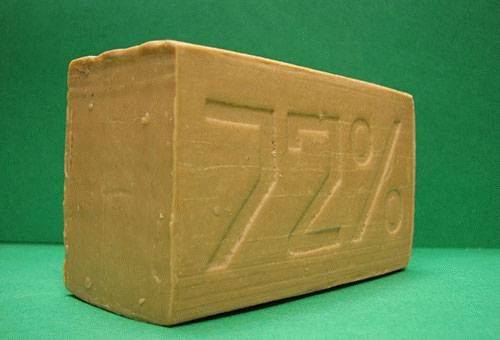
What to do if things still faded
Fortunately, there is a huge selection of industrial and home remedies to help reanimate faded things.
- Vanish products are very popular with housewives. The assortment includes products for both white and colored fabrics. They can be applied directly to stains and added during washing.
- Soap "Antipyatin" will help, which is suitable for all types of fabrics, including even those requiring careful treatment. Despite the fact that its natural ingredients do not cause color fading, when processing colored products it is worth testing its effect on an inconspicuous area. This tool retains its properties even in cold water, which allows you to select the appropriate temperature for washing different fabrics.
- If you washed white and pink due to erroneous sorting, try the following scheme. Soak the garment in a concentrated soap solution using a white laundry detergent for 3 hours. Wash first by hand, then machine wash with the addition of soda ash powder at the maximum temperature. This method is suitable for cotton products.
- If a white thing made from natural materials fades after washing, the recipe of our grandmothers will help - digestion. For bleaching, prepare a solution of 5 liters of water, 40 g of soap shavings, 100 ml of hydrogen peroxide and 10 ml of ammonia.
- It is recommended to soak faded colored items in a special stain remover, which has a mark. After that, wash in the usual way.
In order not to spoil the completely faded clothes, approach the cleaning step by step, having previously studied the instructions. Don't use multiple methods at once.
When clothes accumulate for washing, it is important to sort the laundry not only by the type of fabric, but also by the shade. Colored clothes cannot be washed together
In this case, a combination of related shades is allowed. Clothes of different colors are washed with specialized products. Suitable for white are the corresponding lines Persil, DENI, Mini Risk, LV, AOS, black - Dreft, Cotico, Laska, Perwoll, Clean Home, Vinsinka, BiMax, color - Frosch, Chirton, Perwoll, Flora, Dalli, Ariel , Klar, Help, Alpi. Loose powders and bleaches are not recommended for non-white linen: whitish traces remain. To prevent things from fading, wash in cool water or add wipes that prevent fading: Tech, Heitmann, Fix Price, Punch, Brite.
To preserve brightness and prevent the appearance of faded stains, clothes are sorted by color before washing. Then, in accordance with the paint, a suitable agent is selected and the item is washed. However, what if the item is two-tone? What is the correct way to wash white bedding with scarlet roses or a multi-colored T-shirt? Let's figure out in more detail whether it is possible to wash black with color, and what to do with contrasting fabrics.
Choosing a detergent also matters
Young housewives are interested in the question of whether there are universal detergents for washing any things. There are no universal powders.
To preserve the color and original appearance of products, a product is required that is suitable for this type of material. After all, powders containing bleach are good for white and not suitable for colored items.
Their aggressive components have a bad effect on pigments and patterns on fabrics. They blur, losing their beauty and brightness. When white and gray are processed together, impurities appear on white things that are difficult even to bleach.
A stain remover can cope with them, having a detrimental effect on the color palette.
At the same time, detergents for colored products contain special additives that fix paints and help wash off dirt.
Their processing of white things leads to the appearance of a gray tint.
Using all-purpose products will remove dirt, but not freshen or bleach the fabric. For this purpose, you will have to look for other products and bleaches.
What do experienced housewives think about this
Can all things be washed with one detergent?
Taking into account many years of experience, experienced housewives have come to the conclusion that the use of a universal detergent for different types of fabrics is permissible only in exceptional cases.
In this case, you first need to carefully study the composition of the product. It should not contain bleaching and aggressive ingredients.
When using similar powders for light-colored products, it is recommended to add 3-5 tbsp to the conditioner container. l vinegar, which will refresh the brightness and saturation of colors.
But it is better to use an appropriate tool for machine and manual processing of things. This will allow you to achieve crystal whiteness and preserve color for products from different types of fabrics.
Sorting rules
First, very dirty things are separated from simply worn ones (for example, work clothes from home clothes). Then the laundry is sorted by color so that there is no mutual coloration. Well, it is advisable to familiarize yourself with the composition. Each type of fiber requires its own washing regime, they often do not coincide: for cotton and silk, wool and linen.

Paired items (socks) are washed at the same time, so as not to make up a set from what is. It is good when a suspicious thing has been tested by time, and the hostess is firmly convinced that she is not threatened by extraneous staining. It is advisable to wash bright T-shirts, blouses separately, without mixing with anything. White too. Some things can only be washed by hand; again, tips for this can be found on the manufacturer's label.
Lingerie, especially women's underwear, is washed separately from other things and in special bags. This is done so that the beloved bust does not stretch, break and catch in the drum, and retain its qualities for a long time.
Drying: where and how?
It is necessary to dry white things immediately after washing, without leaving them for a long time in the drum of the machine or in the basin, since things can at the same time acquire an unpleasant smell and go with stains and smudges. The clothes are wrung out from excess water, and dried in a straightened form.
How exactly to dry a thing depends on its type and material:
- woolen sweaters - in a horizontal position on a terry towel;
- linen and bedding - by throwing it over the clothesline;
- blouses and shirts - on a trempel;
- T-shirts - on a rope, using clothespins.
To speed up the drying process of white clothes, do not place them on heating devices, near a source of open fire. Clothes dry best outdoors and in dry rooms.
It is necessary to provide them with the opportunity to dry in a straightened form, without touching walls and other clothing. Before hanging white items on a drying line outside, make sure it is clean.
Sorting and preparation rules
It is recommended to adhere to the following tips:
- First sort the laundry by color. Lay out white, black and colored items separately.
- Conduct a separate sorting of colored items. Separately put clothes in dark and light shades.
- Separate items sorted by color according to their type of fabric. You can group cotton and linen garments and separate them from wool and silk. Put synthetics separately. Sort delicate colored and lace underwear into a separate pile.
- Arrange things depending on the mode of washing. Colored towels and bed linen are placed separately. They are washed at a higher temperature. The rest of the items should be washed at a low temperature.
- Sort products according to their degree of contamination.Very dirty clothes and items with old stains should be placed in a separate pile.
If the items are heavily soiled, it is recommended to prepare them for washing by soaking. You can use laundry soap for this.
They rub the problem area of the thing and leave it for an hour. You can also soak the entire garment in soapy water for several hours.
Colored laundry must be turned inside out before any wash. This way it will better retain its color.
When washing colored laundry, you need to take into account simple recommendations:
It is forbidden to wash colored items together with black linen. Failure to comply with this recommendation can lead to damage to bright things. After buying a colored product, be sure to wash it with things of a similar range. If you bought a blue T-shirt, then you can safely wash it with blue towels, because if it fades, then the towels will receive the saturation of their shade. Use soft water to wash colored items. To determine the level of hardness, you can use the following advice: send 25 grams of soap to 250 ml of hot water, it should dissolve quickly without sediment, if the water is soft. To make the water soft, you can use modern scientific developments - the funds are present on store shelves. Before washing, be sure to soak bright tights, knee-highs, socks in the prepared solution. To do this, you need to mix a glass of warm water with 50 grams of boric acid. Insist the solution for an hour. Overalls and heavily soiled colored items need to be soaked before washing. It is necessary to use laundry soap, boiling water, soda and kerosene. Add 75 grams of laundry soap to water, then add a spoonful of soda, add kerosene in an amount of 180 ml. Rub with this composition of pollution. Leave the items in this position for at least 7 hours. Then wash in the usual way
In order for things made of linen to retain their color brightness, it is important to wash them correctly. Need to add vinegar when washing
Use cool water for rinsing. In order for pink, yellow, blue clothes to remain bright, you need to rinse them in a solution with 9 percent vinegar. For machine care use 125 ml 95% vinegar. For blue, red products, you need 15 grams of salt when rinsing. Mohair garments must be rinsed in a solution of water and glycerin after washing. It takes 3 tablespoons of the substance. This will ensure the color fastness and softness of the fabric.




